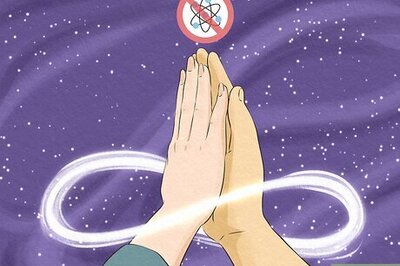
views
What does hiyakasudere mean?
Hiyakasudere is a character that enjoys teasing their love interest. In Japanese anime and manga, there are a number of “dere” archetypes that speak to a character’s behavior and personality. Hiyakasudere characters are known for playful flirting, teasing, and suggestive remarks, often directed toward the character they’re romantically interested in. The term hiyakasudere is a combination of the Japanese words “hiyakasu” (to banter, make fun of, or jeer) and “deredere” (to be lovestruck). Some fans have speculated that hiyakasudere characters would have an ENTP or ESTP MBTI personality type; both types are bold, extroverted, quick-witted, and great at verbal sparring!
Hiyakasudere Characteristics & Personality
Hiyakasudere tend to be female characters. While the “hiyakasudere” (or “teasedere”) archetype isn’t exclusive to female characters, it’s more common for hiyakasuderes to be female. You might see a female hiyakasudere tease her love interest and then walk away, leaving the male love interest looking flustered (usually because he finds the hiyakasudere attractive). Still, there are some male hiyakasuderes too; the archetype generally describes behaviors and personality traits rather than a specific gender. Male characters tend to fall under different character archetypes, like sukebe (which is a lewd or lecherous character) or charao (which is simply a term for a flirtatious male character).
Hiyakasudere are initially teasing, flirty, and playful. They enjoy flustering the people they have a crush on, and thus often make suggestive comments or teasing quips to get a rise out of them. Hiyakasudere find their love interest’s flustered reaction adorable—which makes them keep up the teasing. Sometimes, hiyakasudere use humor and playful flirtation to hide the true depths of their feelings for their love interest. This is sometimes called the “hiyakasu” or “tease” period, referring to the start of a character’s arc when they mainly rely on humorous flirts to communicate. Hiyakasudere don’t seduce their love interests directly; they casually tease to see if their love interest has feelings for them without being vulnerable or admitting their feelings in return. Often, a hiyakasudere’s love interest won’t realize the hiyakasudere is in love with them, and will assume they’re just flirting for fun—which can lead to miscommunications later.
They eventually learn to be more serious and honest about their feelings. Over time, hiyakasudere characters often realize that their love interest isn’t taking their playful flirting seriously—and that continuing to tease them won’t take the relationship to the next level. After that, they take things more seriously, and rather than teasing, they try to open up to their love interest and confess how they feel. This is sometimes called the “dere” period, when the hiyakasudere has changed and begun acting more lovestruck and romantic. Once in a relationship, hiyakasudere characters don’t necessarily stop teasing their partner; they might still say (or whisper) something suggestive to get their partner flustered.
Alternate Archetype Names
Hiyakasudere is an alternate name for the “teasedere” archetype. Teasedere is the official name for this character archetype, combining the English word “tease” (to make fun of or playfully provoke) with the Japanese word “deredere” (to be lovestruck). However, the term “hiyakasudere” has become popular online, likely as a way to make the archetype name sound more Japanese. The term “teasedere” was originally created to describe the personality of Holo, a character from the Spice and Wolf anime series. Interestingly, the word “hiyakasu” implies more malice, rudeness, and ridicule than the word “tease,” (which is more about playfully provoking someone). Thus, “hikayasudere” technically isn’t quite an accurate translation of “teasedere,” even the two terms represent the same archetype and can be used interchangeably.
Similar “Dere” Character Archetypes
Erodere Erodere is a more direct and suggestive version of hiyakasudere. While hiyakasudere characters love to flirt and be playful, erodere engage in more dirty talk and won’t hesitate to suggest doing more intimate things with their love interests. Hiyakasudere characters are charming and witty, whereas erodere are very intentionally seductive and erotic. As mentioned above, “charao” is another similar archetype specific to male characters—and like erodere, charao flirt because they’re openly trying to start a relationship with someone (not to get a flustered reaction). Koakuma is an archetype for sultry female characters who openly try to seduce the characters they’re interested in (like charao).
S dere Also called “sadodere,” (or even a “mean teasedere”) S dere is an archetype describing characters who tease their love interests because they enjoy toying with their feelings. They tend to talk down to their love interests and even humiliate them while maintaining a playful attitude, usually because they want to control their love interests in some way. The big difference between S dere and hiyakasudere is the nature of their teasing; S dere are intentionally malicious, while hiyakasudere don’t mean any harm.
Tsundere Tsundere characters are harsh and cold toward their love interests initially, and switch to being warmer and more loving over time. While hiyakasudere and tsundere characters seem very different, they both find ways to mask their feelings for their love interests—and eventually learn to drop those masks and be open with their true feelings. However, tsundere differ by essentially pretending not to care about their love interests and being openly unfriendly at first, whereas hiyakasudere are friendly—they just don’t come off as super genuine.
Hiyakasudere Examples in Anime
Several anime series include well-known hiyakasudere characters. The hiyakasudere archetype has become increasingly common in anime and manga over the years, especially with series like Teasing Master Takagi-san becoming popular. The following anime series have well-known hiyakasudere characters: Ouran High School Host Club: The Hitachiin twins—Hikaru and Kaoru—both fall within the hiyakasudere archetype. They often tease other club members and entertain customers with their playful flirtatiousness. Fruits Basket: Shigure and Ayame Sohma are cousins in Fruits Basket, and they both have playful, teasing personalities—often flirting with Tohru Honda to get a rise out of Kyo and Yuki. Shigure also pokes fun at his love interest, Akito. Fairy Tail: Lucy Heartfilia and Gray Fullbuster are both hiyakasudere! Lucy has a tendency to flirt with enemies to get out of trouble and enjoys teasing Natsu because she has feelings for him. Gray has a more subtle sense of humor, but still uses it to tease Juvia Lockser and other guild members. Don’t Toy With Me, Miss Nagatoro: Hayase Nagatoro could be considered a hiyakasudere; she loves to tease and make fun of her senpai, Naoto, but secretly harbors strong feelings for him. Her teasing also lessens once she admits her feelings. Nagatoro’s friends (Sakura, Yoshi, and Gamo-chan) also fit in the hiyakasudere archetype, as they often egg her on and tease Naoto with her. Kaguya-sama: Love Is War: Both main characters in this series, Kaguya and Miyuki, are hiyakasudere; they have a mutual crush on one another but refuse to address the crush directly. Instead, they continually tease, flirt, and come up with creative schemes and antics to get each other’s attention.

















Comments
0 comment